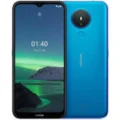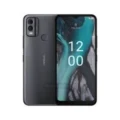Nokia 6300 4G


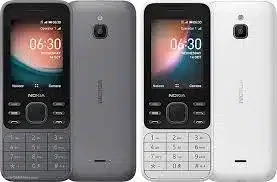
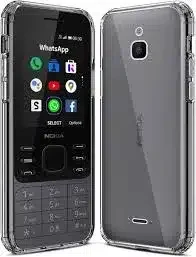

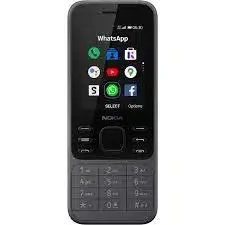
- : 512MB RAM Snapdragon 210
- : 2.4" 240x320 pixels
- : 1500mAh
- : 0.3MP
Introducing the Nokia 6300 4G: a timeless classic reimagined for the modern era. Boasting sleek design and powerful performance, this iconic handset seamlessly blends nostalgia with innovation, offering users a premium mobile experience.
Crafted with precision, the Nokia 6300 4G features a durable polycarbonate shell complemented by a metallic finish, exuding sophistication and resilience. Its compact and lightweight build makes it ideal for on-the-go lifestyles, fitting effortlessly into pockets and purses.
Equipped with 4G connectivity, this device ensures swift and reliable internet access, allowing users to stay connected with friends, family, and the world at large. Whether browsing the web, streaming content, or engaging in video calls, the Nokia 6300 4G delivers smooth and seamless performance.
The vibrant 2.4-inch display provides crisp visuals and easy navigation, enhancing the user experience across various applications and tasks. From reading messages to browsing photos, every interaction is smooth and intuitive.
Capture life’s memorable moments with the Nokia 6300 4G’s 2MP rear camera, which delivers surprisingly sharp and detailed photos. Whether documenting adventures or snapping selfies, this camera ensures that every shot is worth cherishing.
With an impressive battery life, the Nokia 6300 4G keeps up with your busy schedule, providing hours of usage on a single charge. Whether for work or play, you can rely on this device to keep you connected throughout the day.
In addition to its practical features, the Nokia 6300 4G prioritizes user security and privacy. With a dedicated emergency button and robust privacy settings, users can feel confident in their digital safety.
In conclusion, it is more than just a phone; it’s a statement of style, reliability, and innovation. Whether you’re a long-time Nokia enthusiast or a newcomer to the brand, this device offers something for everyone. Experience the best of both with it: timeless design meets modern functionality.
Specs
Network
| 2G Network GSM 850 / 900 / 1800 / 1900 - SIM 1 & SIM 2 (dual-SIM) CDMA 800 / 1900 |
GSM 850 / 900 / 1800 / 1900 - SIM 1 & SIM 2 (dual-SIM model only) |
| 3G Network |
HSDPA 850 / 900 / 2100 - International HSDPA 850 / 900 / 1700(AWS) / 1900 / 2100 - Americas |
| 4G Network |
1, 3, 5, 7, 8, 20, 28, 38, 40 - ROW 1 3, 5, 7, 8, 20, 28, 38, 39, 40, 41 - MENA, GCR 2, 3, 4, 5, 7, 12, 17, 28, 66, 71 - Americas |
| Speed |
HSPA, LTE Cat4 150/50 Mbps |
LAUNCH
| Announced | November, 2025 |
| Status |
Available. Released 2021, January 06 |
BODY
| Dimensions | 131.4 x 53 x 13.7 mm (5.17 x 2.09 x 0.54 in) |
| Weight | 104.7 g (3.70 oz) |
| Build | Plastic frame, plastic back |
| SIMs SIM (Subscriber Identity Module) is a small card that contains mobile network subscriber's account information. This allows the phone using the card to attach to a mobile network. The SIM card is most commonly associated with GSM and UMTS mobile networks. Moving a SIM card from one phone to another allows a subscriber to switch mobile phones without having to contact their mobile network carrier. SIM cards can also be used by a phone to store limited amounts of data, such as phone numbers and text messages. |
Single SIM (Nano-SIM) or Dual SIM (Nano-SIM, dual stand-by) |
Display
| Display Type Display Technology => A number of display technologies and types used in mobile phones => TFT (Thin Film Transistor), IPS (In-Place Switching), OLED (Organic Light Emitting Diode), AMOLED (Active-Matrix Organic Light-Emitting Diode), Super AMOLED (an even advanced version of AMOLED), Resistive Touchscreen (Resistive touchscreens contain two layer of conductive material with a very small gap between them which acts as a resistance), Capacitive Touchsceen (Capacitive touchscreen technology consists of a layer of glass coated with a transparent conductor) | TFT LCD, 16M colors |
| Size | 2.4 inches, 17.8 cm2 (~25.6% screen-to-body ratio) |
| Resolution | 240 x 320 pixels, 4:3 ratio (~167 ppi density) |
PLATFORM
| Operating System OS => Every computer system run on a base software called Operating System (OS). Operating System controls all basic operations of the computer (such as smartphone, PDAs, tablet computers and other handheld devices). The Operating System allows the user to install and run third party applications (apps), apps are used to add new functionality to the device. | KaiOS 2.5 |
| Chipset Chipset is a group of integrated circuits designed to perform one or a more dedicated functions, often with real time computing constraints, Popular smartphones are equipped with more advanced embedded chipsets that can do many different tasks depending on their programming. | Qualcomm QC8909 Snapdragon 210 (28 nm) |
| CPU CPU (Central Processing Unit) mostly known as processors, CPU processes instructions in order to carry out certain functions that make your device operate properly. Processors are often described as the brain of computers, smartphones and tablets, Smartphones and tablets rely on processors to carry out their every task, Processors are an incredibly important factor in selecting any type of computing device, including your smartphone. | Quad-core 1.1 GHz Cortex-A7 |
| GPU GPU (Graphics Processing Unit) is a single-chip processor designed to rapidly manipulate and alter memory to accelerate the creation of images in a frame buffer intended for output to a display, This includes things such as lighting effects, object transformations, and 3D motion. | Adreno 304 |
MEMORY
| Card Slot Memory Card Slot is a special slot for inserting a memory card. Memory cards allow you to expand the phone's built-in memory, A memory card (sometimes called a flash memory card or a storage card) is a small storage medium used to store data such as text, pictures, audio, and video, for use on small, portable or remote computing devices such as mobile phones, mp3 players, digital cameras. | microSDHC |
| Internal | 4GB 512MB RAM |
MAIN CAMERA
| Cameras Specs Today’s smartphones come equipped with a very comprehensive set of camera related specifications. Our smartphone, for many of us, has become our primary camera due to it being the one we always have with us. |
VGA |
| Camera Features |
LED flash |
SELFIE CAMERA
| Cameras Specs Today’s smartphones come equipped with a very comprehensive set of camera related specifications. Our smartphone, for many of us, has become our primary camera due to it being the one we always have with us. |
No |
SOUND
| Loudspeaker | Yes |
| 3.5mm jack |
Yes |
COMMS
| WLAN |
Wi-Fi 802.11 b/g/n, hotspot |
| Positioning |
GPS, GLONASS |
| Bluetooth Bluetooth is a wireless communications technology for exchanging data between mobile phones, headsets, computers and other network devices over short distances without wires, Bluetooth technology was primarily designed to support simple wireless networking of personal consumer devices. | 4.0, A2DP |
| Infrared Infrared connectivity is an old wireless technology used to connect two electronic devices. It uses a beam of infrared light to transmit information and so requires direct line of sight and operates only at close range. | |
| USB | microUSB 2.0 |
| NFC NFC (Near field communication) is a set of standards for smartphones and similar devices to establish peer-to-peer radio communications with each other by touching them together or bringing them into proximity, usually no more than a few inches. | |
| Radio |
Features
BATTERY
| Battery Type Battery Type => Cell phones run on various kinds of batteries depending on the manufacturer, phone size or shape and features. There are basically four types of cell phone batteries => Lithium Polymer, Lithium Ion, Nickel Metal Hydride and Nickel Cadmium. | Li-Ion (Lithium Ion) |
| Capacity Battery Capacity is a measure (typically in Amp-hr) of the charge stored by the battery, and is determined by the mass of active material contained in the battery. The battery capacity represents the maximum amount of energy that can be extracted from the battery under certain conditions. | 1500 mAh |
| Placement | Removable |
MISC
| Colors |
Light Charcoal, White, Cyan Green |
| Model | TA-1294, TA-1291, TA-1287, TA-1286 |
| SAR EU Each GSM handset has a radio transmitter and receiver in order to operate in the wireless GSM network. That transceiver is manufactured so that when used next to the ear and when worn on the belt, it won't exceed the limits for exposure to radio frequency energy set by the authorities.The authorities in question here are the Federal Communications Commission (FCC) of the U.S. Government, Industry Canada of the Canadian Government (IC), and the Council of the European Union. |
1.09 W/kg (head) 1.77 W/kg (body) |
| Price |
About 80 EUR |
TESTS
Reviews
Offers
-
 Nokia 6300 4G | Unlocked | Dual SIM | WiFi Hotspot | Social Apps | Google Maps and Assistant | White (Renewed)
$200
Nokia 6300 4G | Unlocked | Dual SIM | WiFi Hotspot | Social Apps | Google Maps and Assistant | White (Renewed)
$200
View Offer
Disclaimer Note
We strive to maintain accurate and up-to-date content on our website for general information purposes only. Please refrain from using the material for business, legal, or any other decisions.




